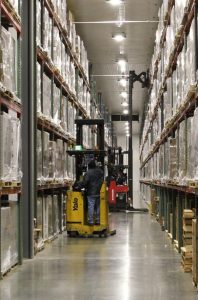
Three methods to support changing behaviors and increasing forklift safety.
You’re going to remember the time when you thought it wouldn’t happen to you. One of your industry contacts was telling you how they paid substantial OSHA fines for allowing operators to use a forklift even after the operators completed pre-use operational compliance checklists that showed said forklift was non-compliant. The individual said he didn’t know the operators were saying that the forklifts weren’t in compliance. Operators said no one paid attention. “He said”/“she said” turned into a story too frustrating not to share. And then it turned into your own worst nightmare when it happened at one of your facilities. Unfortunately for many logistics executives and warehouse general managers, this situation is all too real because of a lack of control and insight into forklift safety. Thanks to advancements in forklift-based technologies, such as fleet and operator management systems, these instances may start to decline because of the availability of critical information that affords the opportunity to create and maintain a culture that champions safety. And if your forklift operator behavior can be changed, then it is likely they will be safer – and your facility performance metrics will be better.
Here are a few methods logistics managers and executives are employing to change behavior related to forklift safety.
Limit access by using a digital compliance checklist
The easiest way to avoid being part of the story at the beginning of this article is not allowing operators to use forklifts they deem out of compliance. Today’s forklift fleet and operator management technologies are equipped with safety-based applications that manage equipment access and operator certification and streamline pre-shift inspections. New technologies control equipment access by requiring operators to enter a login prior to use.
When it comes time to conduct a safety inspection prior to using a forklift, it’s easy for an operator to check the boxes on a sheet of paper acknowledging that he or she has evaluated the forklift before using it. It’s not easy to keep track of the paper documents, review them in real-time to gauge compliance, or to tell how quickly that sheet of paper was filled out. Insert a digital compliance checklist, and you’re equipped with the data to take the mystery out of the equation.
If an operator does not deem the forklift to be in compliance, then the forklift will not start. You also have an easily accessible soft copy of the checklist that can be shown to OSHA – as opposed to scrambling to find the hard copies that may or may not still be with the forklift or in an accessible file.
This process helps keep operators accountable, and allows managers to track performance by forklift and operator and be alerted to special events, such as impacts. And, engaging with the technology has never been easier for operators. Many forklift-mounted devices are based on tablet computers that operators are familiar with from their personal lives.
Monitor and analyze meaningful impacts
When a forklift is involved in an impact event, it is important that on-board technology is advanced enough to separate fact from fiction. Apathy toward impact alarms is understandable considering as many as 70 percent of impact alarms were considered to be nuisance alarms with past technologies. The technology must be reliable and meaningful in order for managers to identify, encourage and enforce a change in operator behavior. A scalable, high-quality impact-sensing system is an essential component.
Once impact monitoring is in place, the system can analyze impact events and provide managers with an easy-to-monitor visual cue for when impacts require their attention. Operators understand that impacts can be easily audited to determine responsibility. As a result, truck damage from impacts generally decreases and safety increases. In addition, ongoing monitoring makes it easier to identify operators who require additional training or locations that are accounting for a high percentage of impacts. Real-time coaching provides direct evidence of a forklift safety culture.
Establish forklift safety benchmarks
While there is nothing new about the importance of benchmarking progress against goals, forklift fleet and operator management technologies do bring new opportunity to this simple practice in the form of evaluation metrics that can be customized by organization and individual. This also enables consistency across shifts or even multiple facilities. Forklift safety isn’t something that can be practiced once and then neglected. The only way managers can effectively help operators change behavior is by demonstrating and recognizing safe performance on a daily basis.
The presence of the technology on the forklift – as well as clearly articulated benchmarks – supports a safety culture that stands to improve overall performance and productivity. The technology also provides the needed data to have meaningful continuous improvement and training discussions with operators.
As logistics executives and warehouse general managers evaluate the safety goals of their facilities, it is important to consider how new forklift-based technologies can make a positive impact. Collaborate with forklift manufacturers to gain a clear vision for how the ideal facility will operate and how the forklifts will align with this plan. Each operation is unique, and the only way to truly develop the best solution for changing behavior is to gather actual performance data to inform relevant discussions and future decisions.
Source: Inbound Logistics



